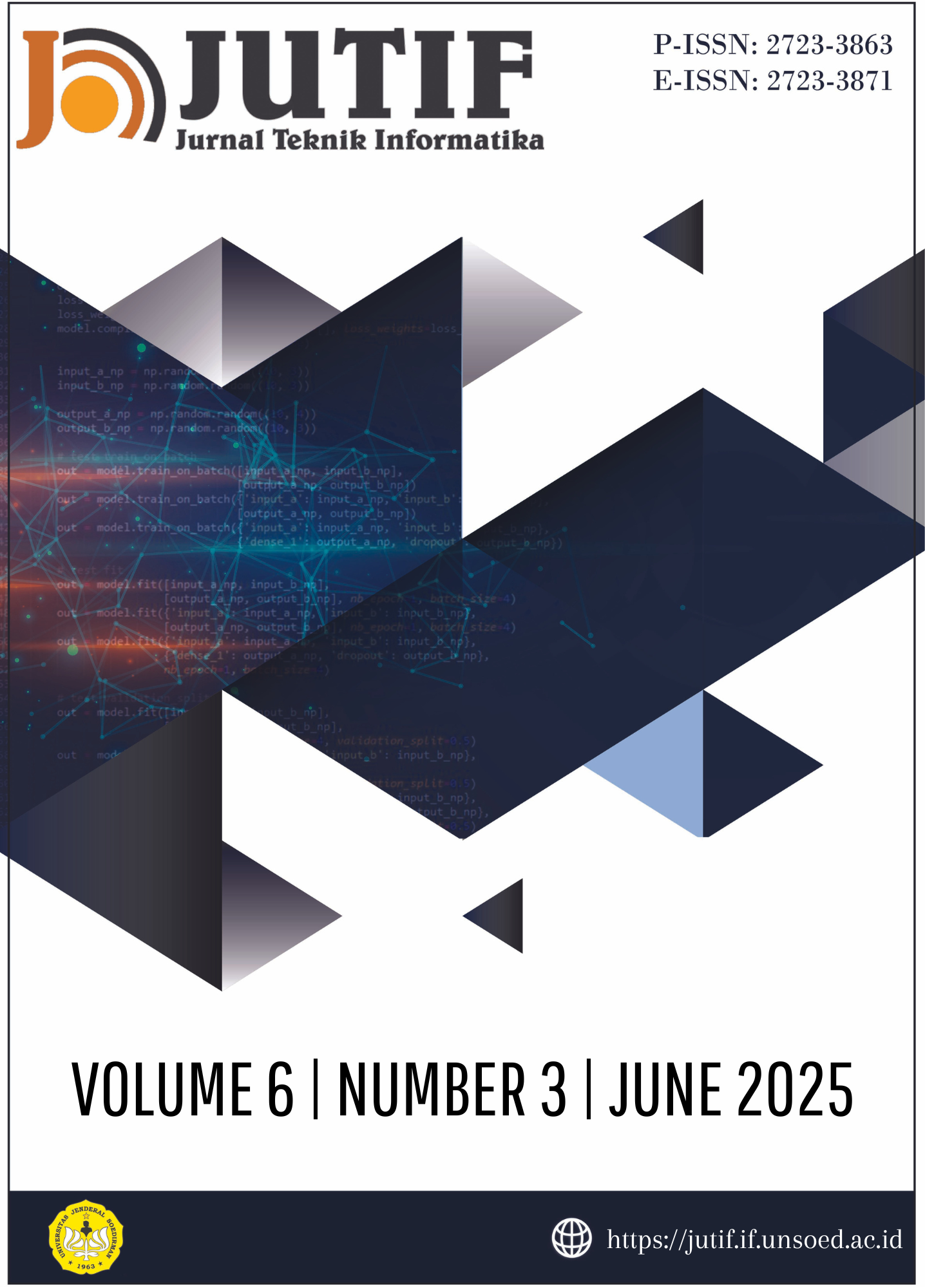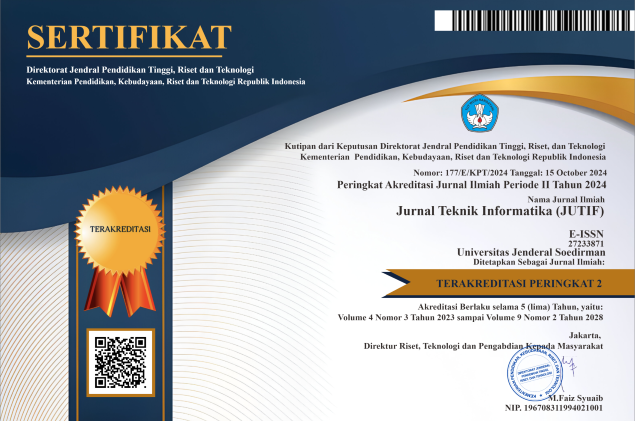Improving Semantic Segmentation of Flood Areas Using Rotation and Flipping-Based Feature Augmentation
DOI:
https://doi.org/10.52436/1.jutif.2025.6.3.4564Keywords:
Deep Learning, Feature Augmentation, Fully Convolutional Network (FCN), Semantic SegmentationAbstract
Semantic segmentation is one of the powerful methods for analyzing flood video or picture data captured by smartphones. However, achieving accurate semantic segmentation requires the application of several methods. In this work, we address the task of feature augmentation approach using rotation (90°, 180°, 270°) and flipping (horizontal, vertical) to improve semantic segmentation of flood areas in Parepare city using a Fully Convolutional Network (FCN). The experimental results demonstrate that the best augmentation scenario 270° rotation achieved an accuracy of 88% and 90° rotation achieved an mean Intersection over Union (mIoU) of 43%, significantly outperforming the baseline FCN model without augmentation, which achieved 86% accuracy and 35% mIoU.
Downloads
References
RENY SRI AYU ARMAN, “Banjir Melanda Parepare, Dua Warga Meninggal,” Feb. 02, 2023. [Online]. Available: https://www.kompas.id/baca/nusantara/2023/02/02/banjir-melanda-parepare-dua-orang-warga-meninggal-dunia?open_from=Tagar_Page
U. Sideng, S. Nyompa, and N. C. Rahayu, “PEMETAAN TINGKAT KEKRITISAN UNTUK DAERAH RESAPAN (WILAYAH STUDI KASUS KOTA PAREPARE),” JES, vol. 4, no. 1, Dec. 2021, doi: 10.35580/jes.v4i1.22393.
Muh. N. Imam, M. Manaf, and K. Aksa, “Mitigasi dan Adaptasi Bencana Banjir Rob di Kelurahan Cappa Galung Kecamatan Bacukiki Barat Kota Parepare,” ursj, vol. 7, no. 2, pp. 224–235, Jun. 2025, doi: 10.35965/ursj.v7i2.6051.
L. Sabbatini, L. Palma, A. Belli, F. Sini, and P. Pierleoni, “A Computer Vision System for Staff Gauge in River Flood Monitoring,” Inventions, vol. 6, no. 4, p. 79, Nov. 2021, doi: 10.3390/inventions6040079.
R. J. Pally and S. Samadi, “Application of image processing and convolutional neural networks for flood image classification and semantic segmentation,” Environmental Modelling & Software, vol. 148, p. 105285, Feb. 2022, doi: 10.1016/j.envsoft.2021.105285.
U. K. Panchal, H. Ajmani, and S. Y. Sait, “Flooding Level Classification by Gait Analysis of Smartphone Sensor Data,” IEEE Access, vol. 7, pp. 181678–181687, 2019, doi: 10.1109/ACCESS.2019.2959557.
J. Wang, L. Song, Z. Li, H. Sun, J. Sun, and N. Zheng, “End-to-End Object Detection with Fully Convolutional Network,” in 2021 IEEE/CVF Conference on Computer Vision and Pattern Recognition (CVPR), Nashville, TN, USA: IEEE, Jun. 2021, pp. 15844–15853. doi: 10.1109/CVPR46437.2021.01559.
J. Ji, X. Lu, M. Luo, M. Yin, Q. Miao, and X. Liu, “Parallel Fully Convolutional Network for Semantic Segmentation,” IEEE Access, vol. 9, pp. 673–682, 2021, doi: 10.1109/ACCESS.2020.3042254.
S.-Y. Huang, W.-L. Hsu, R.-J. Hsu, and D.-W. Liu, “Fully Convolutional Network for the Semantic Segmentation of Medical Images: A Survey,” Diagnostics, vol. 12, no. 11, p. 2765, Nov. 2022, doi: 10.3390/diagnostics12112765.
Z. Luo, W. Yang, Y. Yuan, R. Gou, and X. Li, “Semantic segmentation of agricultural images: A survey,” Information Processing in Agriculture, vol. 11, no. 2, pp. 172–186, Jun. 2024, doi: 10.1016/j.inpa.2023.02.001.
N. S. Inthizami et al., “Flood video segmentation on remotely sensed UAV using improved Efficient Neural Network,” ICT Express, vol. 8, no. 3, pp. 347–351, Sep. 2022, doi: 10.1016/j.icte.2022.01.016.
M. Rahnemoonfar, T. Chowdhury, A. Sarkar, D. Varshney, M. Yari, and R. R. Murphy, “FloodNet: A High Resolution Aerial Imagery Dataset for Post Flood Scene Understanding,” IEEE Access, vol. 9, pp. 89644–89654, 2021, doi: 10.1109/ACCESS.2021.3090981.
B. Neupane, T. Horanont, and J. Aryal, “Deep Learning-Based Semantic Segmentation of Urban Features in Satellite Images: A Review and Meta-Analysis,” Remote Sensing, vol. 13, no. 4, p. 808, Feb. 2021, doi: 10.3390/rs13040808.
S. Soares, G. M. Fernandes, and F. R. P. Rocha, “Smartphone-based digital images in analytical chemistry: Why, when, and how to use,” TrAC Trends in Analytical Chemistry, vol. 168, p. 117284, Nov. 2023, doi: 10.1016/j.trac.2023.117284.
K. Alomar, H. I. Aysel, and X. Cai, “Data Augmentation in Classification and Segmentation: A Survey and New Strategies,” J. Imaging, vol. 9, no. 2, p. 46, Feb. 2023, doi: 10.3390/jimaging9020046.
T. Kumar, R. Brennan, A. Mileo, and M. Bendechache, “Image Data Augmentation Approaches: A Comprehensive Survey and Future Directions,” IEEE Access, vol. 12, pp. 187536–187571, 2024, doi: 10.1109/ACCESS.2024.3470122.
N. S. Intizhami, E. Q. Nuranti, and N. I. Bahar, “Dataset for flood area recognition with semantic segmentation,” Data in Brief, vol. 51, p. 109768, Dec. 2023, doi: 10.1016/j.dib.2023.109768.
T. Agustin, E. Utami, and H. A. Fatta, “Implementation of Data Augmentation to Improve Performance CNN Method for Detecting Diabetic Retinopathy,” in 2020 3rd International Conference on Information and Communications Technology (ICOIACT), Yogyakarta, Indonesia: IEEE, Nov. 2020, pp. 83–88. doi: 10.1109/ICOIACT50329.2020.9332019.
R. Bravin, L. Nanni, A. Loreggia, S. Brahnam, and M. Paci, “Varied Image Data Augmentation Methods for Building Ensemble,” IEEE Access, vol. 11, pp. 8810–8823, 2023, doi: 10.1109/ACCESS.2023.3239816.
E. Goceri, “Medical image data augmentation: techniques, comparisons and interpretations,” Artif Intell Rev, vol. 56, no. 11, pp. 12561–12605, Nov. 2023, doi: 10.1007/s10462-023-10453-z.
G. Zhou, Y. Chen, and C. Chien, “On the analysis of data augmentation methods for spectral imaged based heart sound classification using convolutional neural networks,” BMC Med Inform Decis Mak, vol. 22, no. 1, p. 226, Aug. 2022, doi: 10.1186/s12911-022-01942-2.
H. Li, J. Fan, Q. Hua, X. Li, Z. Wen, and M. Yang, “Biomedical sensor image segmentation algorithm based on improved fully convolutional network,” Measurement, vol. 197, p. 111307, Jun. 2022, doi: 10.1016/j.measurement.2022.111307.
G. Chen et al., “SDFCNv2: An Improved FCN Framework for Remote Sensing Images Semantic Segmentation,” Remote Sensing, vol. 13, no. 23, p. 4902, Dec. 2021, doi: 10.3390/rs13234902.
M. M. Rahman and R. Marculescu, “Medical Image Segmentation via Cascaded Attention Decoding,” in 2023 IEEE/CVF Winter Conference on Applications of Computer Vision (WACV), Waikoloa, HI, USA: IEEE, Jan. 2023, pp. 6211–6220. doi: 10.1109/WACV56688.2023.00616.
D. Tribuana, Hazriani, and A. L. Arda, “Image Preprocessing Approaches Toward Better Learning Performance with CNN,” J. RESTI (Rekayasa Sist. Teknol. Inf.), vol. 8, no. 1, pp. 1–9, Jan. 2024, doi: 10.29207/resti.v8i1.5417.
J.-S. Hwang, S.-S. Lee, J.-W. Gil, and C.-K. Lee, “Determination of Optimal Batch Size of Deep Learning Models with Time Series Data,” Sustainability, vol. 16, no. 14, p. 5936, Jul. 2024, doi: 10.3390/su16145936.
Additional Files
Published
How to Cite
Issue
Section
License
Copyright (c) 2025 Naili Suri Intizhami, Eka Qadri Nuranti, Nur Inaya Bahar

This work is licensed under a Creative Commons Attribution 4.0 International License.



























